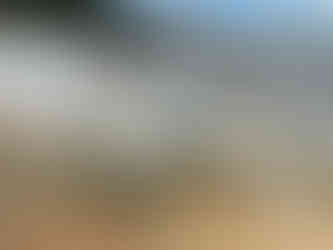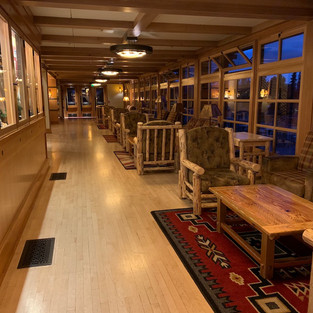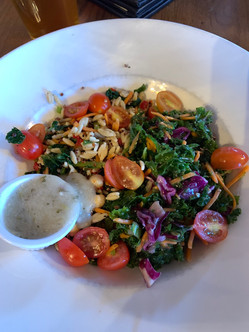Yellowstone & Grand Tetons Part 1: Montana, Yellowstone (Mammoth to Geyser Basin) & Travel Tips
- Meghan Perkins
- Jan 30, 2021
- 20 min read
Updated: May 28, 2022

This is Part 1 of a planned 5 part series on Yellowstone and Grand Tetons National Parks. We will spend 5 days and nights exploring the natural wonders of each park and the surrounding cities. Our travels will take us on a circuitous route from Bozeman, MT to Jackson Hole, WY and back again. We'll encounter a plethora of unique sights along the way--this landscape is not replicated anywhere else in the world. If you're on the fence about planning a trip to Yellowstone and/or Grand Tetons, I hope this series encourages you to take the plunge!
It's day 1 of our trip to Yellowstone and Grand Tetons National Parks, and we have a pre-dawn start to a very busy day this morning. However, for once, I have no trouble getting up--I'm much too excited to sleep. We are headed to the airport for our flight cross-country to Bozeman, Montana. I've never been to either Montana or Wyoming, so I'm looking forward to exploring two new states, as well.
Yellowstone is immense, covering nearly 3,500 square miles of wilderness. The park stretches across three states, though the majority falls within the boundaries of Wyoming. With such a vast area of land and several entrances into the park, there are a few options for airports* surrounding the park's immediate vicinity depending upon your itinerary. We are beginning our park trip in Yellowstone, where we will be spending the majority of our stay (4 out of 5 nights). For our itinerary and origin destination, Bozeman's airport makes the most sense. By flying into Bozeman--the largest of the airports and located closest to Yellowstone's north entrance--we are able to get direct roundtrip flights (and as an added bonus, use airline miles with our carrier).
It's late July (about to be August), so we have our pick of airports and park entrances*--and hopefully good weather. Mid-June to early September are the best times to visit Yellowstone to avoid snow and cold temperatures. Even at this time of year, though, the daily temperature* can fluctuate rather dramatically. The average daily high is 72F and the low is 38F. It's also the driest time of year with an average of 5 days of precipitation per month (as opposed to December which averages 26F and 4F respectively with 13 days of precipitation) [Source: NOAA]. With unpredictable weather and fluctuating temperatures, I've packed* for every contingency imaginable, from bathing suit and shorts to a winter coat, hat and gloves.
With all the weather contingencies we've packed for, we have to check our luggage--sometimes it just can't be helped. Our flight out is uneventful, if a bit bumpy. The skies are clear other than a few puffy cotton ball clouds. We soar over flat expanses of crop fields, forming a patchwork quilt across the landscape and tall, jagged mountain peaks, still capped with snow even in mid-summer. I love looking out an airplane's window in-flight, watching the varied landscapes dramatically pieced together below, resembling a giant, 3D jigsaw puzzle.

When we land at Bozeman Yellowstone International Airport, all I can think is that this airport is literally in the middle of nowhere. I'm mainly used to airport in and around large cities. Here, we appear to have landed practically in an empty field next to a mountain. However, according to our map (and my pre-trip research), downtown Bozeman is only a short 10 miles away--directly on our route to Yellowstone. Given the opportunity to visit Montana, I couldn't resist planning a quick visit to at least a few of the cities we'll pass along the way. So, after collecting our luggage and rental car, we're off to our first stop--Main Street, Bozeman, MT.
Our drive to the park's north entrance would take about 1.5 hours without stops; however, I have planned out three short detours in Montana along the way. The first is obviously Bozeman. Since it's also lunch time, I've researched a few local restaurants where we might be able to get a quick meal. We settle on Starky's, a New York style deli and American restaurant. The irony of flying out west to immediately go to a NY style deli is not lost on me, but I've heard their reuben is famous. My husband opts to be healthy and order the super greens salad with salmon which comes with blueberries, goat cheese, avocado, almonds, cucumber, and a honey black pepper vinaigrette. I do not stay quite so healthy, though, and decide I must try the famous reuben which comes with the usual corned beef, swiss cheese, sauerkraut, and russian dressing on grilled rye bread. I also add a side salad--that makes the meal healthy, right?
After our lunch, we explore a bit of downtown Bozeman, walking down Main Street and stopping in a cute local coffee shop, Wild Joe's, for some caffeine (their baked goods look so good that I also purchase some to take with us for later). Bozeman has a retro, artsy vibe with a bit of college town mixed in--which make sense as it is home to Montana State University. I immediately like it and can definitely see why it's been voted a top livable city. Bozeman feel authentic, with non-chains lining Main Street and colorful art dotting the city blocks. To reinforce the retro vibe, we even see a classic car stopped on the street in front of an old-school looking concert hall--quintessential Bozeman.

Refueled and caffeinated, we get back on the road. We are once again head toward Yellowstone, traveling about 30 minutes along I-90 East. At the junction of I-90 and US 89, though, instead of heading south on US 89 toward the park, we hop off the exit for Livingston, MT. Livingston is essentially right off the main road, so it makes another good stop without going out of our way. Livingston is a former railroad town with an old-west feel. The city sprawls out from it's old-town feeling Main Street and appears to slowly have modernized and then frozen in time along the way with a retro vibe in the area immediate surrounding Main Street and a modern feel in the areas furthest out. Main Street is by far my favorite, though, with its 19th century brick buildings sporting some wonderful old painted advertisements, craftsman signs, and beautifully detailed facades.
Livingston looks to have some fun local bars and eateries--I particular enjoy a few of the local establishments' advertisement signs. I'd love to stop to sample a few local brews or some of the cuisine, but we have a lot more driving still to do today, and we just ate lunch. So, after a bit more exploring on foot, we're off again--headed south on US 89 toward Yellowstone's north entrance.

Along this section of US 89, the road becomes a bit more scenic, and we even pull off at a few opportune spots to take some snapshots. Montana is made for outdoor enthusiasts. Everywhere were look, there are rafters and cyclists and hikers. This warm, clear day seem to have enticed everyone out into the summer sunshine.

Within an hour, we are in Gardiner, Montana--our final stop before entering the park. This gateway town, with a population of under 1,000 residents, is touristy, housing all of the typical infrastructure you would expect to find bordering a major attraction--lodging, guided expedition companies, and quick-bite eateries. However, the scenery in around the city's tourist kitsch is appealing. The Yellowstone River runs directly through Gardiner, making it a popular spot to book rafting tours. Additionally, Gardiner is home to Yellowstone's famous Roosevelt Arch (pictured below). The 50 foot high archway was designed to beautify Yellowstone's northern entrance. Constructed in 1903, and featuring a cornerstone laid by President (Theodore) Roosevelt himself, it is safely accessible on foot for an up-close look thanks to some pedestrian improvements made in 2018.
As we drive through the park's ticketing booth, we have several ticketing options, ranging from 7 consecutive days to an annual pass. We could buy individual 7 day passes for both here and Grand Tetons National Park (the cheapest option), but for an extra $10, we decide to opt for the American the Beautiful Pass which is good for a year and covers over 2,000 federal recreation sites across the country (including Yellowstone and Grand Tetons). Our new pass in hand, we officially begin our journey into Yellowstone.
We have been advised to keep a constant lookout for interesting wildlife along the roadways in the park, and not 2 miles into our journey, we have our first encounter. (It's often easy to tell wildlife is up ahead in Yellowstone since the traffic dramatically slows as everyone stops to get a better look.) Our first sighting happens to be a band of bighorn sheep grazing on a steep, rock-faced hillside. The park houses 10-13 bands of these sheep, residing in different locations depending upon the season, but they can be spotted year round in the area between the park's north entrance and Mammoth Hot Springs. We are lucky enough to get a chance to view them in just that spot.
The roads from each of Yellowstone's five entrances (north, south, east, northeast, and west) all converge upon Yellowstone's Grand Loop Road which actually consists of a Lower Loop and an Upper Loop (the bottom of the upper loop and the top of the lower loop share a border). Getting around the park is not fast--the grand loop is 142 miles long with a speed limit of 45 mph. With hairpin turns, reduced speed in many spots, and the occasional bison herd halting traffic, it's slow going. However, there is plenty to see and do along the way to break up the drive, with many of the park's best sights easily accessible from the main roads--plus the occasional roadside wildlife sighting.
Map of Yellowstone

Source: nps.gov/yell (you can find the map link here)
Our final destination today is the Old Faithful Snow Lodge, our accommodations for the next two evenings. It's near the south-west corner of the Lower Loop, so we have a good bit of a drive through the park to get there. Along the way, I've mapped out a few key stops to both break up the drive and get a small taste of the park's many highlights today.
Photos: Mammoth Hot Springs Lower Terrace and Boardwalk (top left: Liberty Cap, a dormant hot spring cone)
About 15 minute (5 miles) south of the park's north gate, we come upon Mammoth Hot Springs. We are spending the last night of our trip here (the culmination of our grand loop back north), but it's our first encounter with the park's hot springs. I can't resist the urge to check out some of the terraced boardwalks, easily accessible from the adjoining parking lot. To conserve time, we stick to the lower terraces and save the upper section (and the highest portion of the "lower terrace") for our trip back.
The lower terraces are all pedestrian traffic only, but the upper terraces also consist of a one-way loop road that can be driven in summer (cars only). Traversing the different boardwalks and overlooks at Mammoth Hot Springs (and taking in all of the subsequent scenery) can consume quite a bit of time. The lower boardwalks alone cover about 1.75 miles and a 300 ft elevation gain, and even driving through the upper terrace loop (1.5 miles), the going can be very slow, with drivers stopping frequently to take in the sights.
The weather today is ideal for getting some reflective shots in the springs' shallow pools and we take full advantage of it. The reflected blue skies and clouds above are the perfect contrast to the rusts, oranges, and greens carpeting the pools of Mammoth Hot Springs. The colorful appearance of Yellowstone's hot springs are the result of heat-loving microorganisms called thermophiles. The temperature and pH of the water determines what thermophiles will thrive in a particular spot, so Yellowstone's varying geology can be thanked for the rainbow of colors found throughout the park.
Photos: Top: Golden Gate Canyon; Bottom Left: Heron Pond, Swan Lake; Bottom Right: Roadside Elk
Back in the car and headed south, we are now traveling on the road from Mammoth to Norris (the west side of the upper loop). It's a 21 mile stretch of road, taking about an hour to traverse without stops. We pass a section of hoodoos (massive boulders that have fallen from the mountains above) and drive through Golden Gate Canyon (named for the rock's golden appearance). At Heron Pond, Swan Lake, we pull off for a quick look. This area is known for its birdwatching--thus the apt names--but we don't stay long enough to take in much of the avian population. Continuing our drive, we pass the turnoff for Sheepeater Cliffs (made up of hexagonal basalt columns) and Obsidian Cliff (comprised of a form of volcanic glass) before finally arriving at the Norris Geyser Basin.

Two distinct sections make up the Norris Geyser Basin--the Porcelain Basin (notable for its hot springs and pools) and the Back Basin (notable for its geysers)--with the Norris Geyser Basin Museum situated between the two. Each is worth the time it takes to explore. The Norris Geyser Basin is the park's hottest geyser basin, and the ground is quite literally steaming around us. We skip the museum in the interest of time (outdoors feels like the best museum here) and head straight past it and down into the colorful Porcelain Basin.
Photos: Norris Porcelain Basin
The 3/4 mile trail leading through the Porcelain Basin is a combination of raised boardwalks and dirt road. (As always in Yellowstone, we are careful not to step off the provided paths.) Immediately, I am struck by the varying colors that dominate this thermal basin. The prevalent milky blue color in the Porcelain basin is a result of a high mineral (silica) content in the water. The orange hues are a result of iron oxide deposits and the blues and greens are due to sulfur and of course the previously mentioned thermophile bacteria mats. It's chemistry and biology working together.
Photos: Norris Back Basin (Left: Steamboat Geyser, Center: Emerald Spring)
Once we've completed our explorations of the Porcelain Basin, we double back and head to the Back Basin. The Back Basin has a 1.5 mile trail circling the major thermal features in this section of the basin. This is our first real brush with geysers, and the first we encounter is the Steamboat Geyser. Geysers can erupt infrequently, continuously, or fairly periodically depending upon a number of geological factors. They can also spew a short distance into the air or hundreds of feet depending upon the water and steam pressure that has been building below the surface. Steamboat Geyser is currently the world's tallest active geyser. During an eruption, it can shoot water more than 300 ft into the air, but its eruptions are fairly infrequent (currently 3-4 time a month). Today, there's just a steady stream of steam and a low spray of water being emitted from the geyser's base.
We wander the trail, taking in the various sights of the basin, to include the colorful Emerald Springs. The aptly named spring gets its greenish hue from a combination of yellow sulfur and the pool's reflective natural blue hue. The pool is 27 feet deep, and the inviting depths look like they would make an excellent swimming hole--too bad the water's temperature is a scorching 182 degrees F. As in the rest of Yellowstone, the water is off limits for a reason.
Photos: Artist Paint Pots and Close-Ups of the Famous Shooting Mud
Back on the road, the next leg of our journey is from Norris to Madison (the northwestern portion of the Lower Loop). It is a 14 mile stretch of road, taking about 30 minutes to travel. About a third of the way through, we have a planned stop at the famous Artist Paint Pots. The Artist Paint Pots are ringed by a 1/2 mile loop boardwalk, but you have to take an easy 1/3 mile dirt trail through the forest from the parking area to get there. The colorful hue of the lower pots (mainly the result of sulfur and iron oxide deposits) give this area its name. The lower, most colorful section, is comprised mainly of boiling pools of water, but the upper section of the loop is why people come to visit this unique sight--the mudpots (actually made of grey clay). The mudpots act much like the other thermal features the park, only when their pressure builds underground, they don't have enough liquid to spew water into the air. Instead, fueled by underground gas bubbles, these features spew mud (up to several feet in the air). Watching them is quite entertaining, but capturing the quick bursts on cameral proves to be difficult!
After a quick reverse hike, we're back in the car--and shortly thereafter, we get to encounter our first bison. The excitement of seeing our first bison is immense--as is the bison. The sheer size of the animal is staggering. It certainly dwarves a cow. We do not exit the car, as the bison is much too close to the vehicle (the park has very strict safety guidelines on keeping your distance from wildlife), but we are able to get an up-close view from the safety of the car. As often with bison, where there is one, there are many nearby, and shortly thereafter, we encounter a whole herd. Here, we are able to get out of the car, and observe the animals grazing from afar for a few minutes.
Finally, after a little more driving, we find ourselves on the last leg of our journey--Madison to Old Faithful (16 miles). There are a lot of famous feastures along this stretch of road (Grand Prismatic Spring, Fountain Paint Pot Nature Trail, Fairy Falls trailhead, Firehole Lake Drive), but we are saving those for tomorrow's explorations as it is getting late. Instead, we head directly to the Old Faithful Snow Lodge--which, despite its name, is open year-round.
Photos: Old Faithful Snow Lodge Property and Premium King Room
I had wanted to stay in the historic Old Faithful Inn. The Old Faithful Inn is Yellowstone's most famous--and therefore most requested--lodging choice. Unfortunately, due to its popularity, it books up well in advance (practically when reservation* dates open). Despite repeated checking for cancellations, I have been unable to secure an available reservation for our dates. So, we will be staying in my second choice--the neighboring Old Faithful Snow Lodge.
The Old Faithful Snow Lodge is more modern (built in 1999) and is actually the park's newest hotel. Our room (category Premium Lodge Room 1 King) is no frills, but it feels clean and has all of the amenities we will need. It come equipped with a desk/chair, armchair/footrest, window seat, king sized bed, and private bathroom. What it does not have is air conditioning--none of the park lodgings do--it's certainly not necessary or missed during our stay.
Photos: Old Faithful Inn
After settling in and freshening up, we're ready to walk next-door to the Old Faithful Inn where we have dinner reservations* in the dining room. First, however, I want to get a closer look at this National Historic Landmark's famous log interior. Built between 1903 and 1904, it is still considered the world's largest log structure. Each floor is open to the airy lobby below, only capped where it encounters the very solid looking log ceiling. The lobby also boasts a gorgeous stone fireplace, sourced with all local material. The architecture is quite stunning, and I can see why the parks free tours of this unique facility are so popular.
We duck out one of the doors of the inn to sneak a quick peek of Old Faithful before it gets too dark (the geyser is literally right outside the hotel). Old Faithful is not scheduled to erupt again until we're eating dinner, so we won't make it tonight, but we have plans to arrive for an early morning eruption tomorrow to beat the crowds. Since Old Faithful erupts about 17 time a day and is fairly predictable (+/- 10 minutes), I'm not too concerned about not getting to witness an eruption while we're staying in the area. (Note: Geyser predictions fluctuate, and eruptions are more predictable for some geysers that others. You can get daily geyser predicted times from the visitors center, your hotel's front desk, or the internet*--twitter @GeyserNPS, at the NPS Yellowstone website, or through a downloadable app--if you happen to have service.)
Back inside the lodge, we stop to listen to the live music being played a floor above us. Live music is often featured in the lobby in the evenings, and tonight is no exception. We climb the lodge's wooden steps to the second floor for a closer look at the musician. As we watch the red bow-tie wearing violinist playing patriotic tunes behind an America flag in a National Historic Landmark in a Nation Park after a day of traveling across America, I think to myself, could this evening get any more patriotic?! The answer is yes, because at dinner, we immediate cap the occasion by ordering American beer.
Tonight we're having dinner at the Old Faithful Inn Dining Room. Reservations* are a must for most of the park's sit-down restaurants, and I made this one months in advance. We decide to start with the Exotic Grains and Kale Salad to share, and for entrees, I choose the Montana Meatballs and my husband gets the Pork Osso Bucco. I'll be honest, the food is definitely not why we are visiting Yellowstone--and that's probably a good thing. Our meals are not the best, but at the end, we're full and ready for a good night's rest. Plus, we cap the meal it off with an ice cream sundae, and any meal that ends with ice cream can't be all bad!
As we walk back to our lodge for the evening, I can't believe how much we have already managed to see and do on the first day of our trip. It's definitely been a jam-packed adventure! I'm excited to see what's in store for us tomorrow when we take on the Lower Loop Road in full. We have a ton of hiking planned and a lot of ground to cover. So for now, it's a good night's rest and an early wake-up call in the morning!
Part 2: Yellowstone Lower Loop (Geysers, Canyons and Waterfalls) coming soon...
*Preparing for Your Trip
When to Visit: Mid-June to early September (peak season) are the best times to visit Yellowstone to avoid snow and cold temperatures. Shoulder season (May to mid-June and mid-Sept to Oct) comes with less crowds, but the threat of snow. In November, as winter heads in, most entrances into the park and roads within the park close to cars. The one exception is the road running from the North Entrance (near Mammoth Hot Springs) to the park's Northeast Entrance, which remains open year-round. In mid-December, the park opens for the "winter season" and other than the afore mentioned exceptions, park entrances and road access is limited to over-snow travel with snowmobiles (guided or by a limited/regulated permit) or commercially operated snow coaches. Additionally, the only park lodgings to remain open in winter are the Mammoth Hot Springs Hotel & Cabins and the Old Faithful Snow Lodge & Cabins.
Weather: In July/August (peak warm/dry season), the average daily high is 72F and the low is 38F. It's also the driest time of year with an average of 5.5 days of precipitation per month. In December/January (peak cold/"wet" season) the average daily high is 27F and the low is 3F with an average of 13 days/month of precipitation. In shoulder season, the weather can be a bit unpredictable; highs average between the 60s and 70s, but lows average below freezing, opening up the possibility for a random snow storm. [Temp/Precip Source: NOAA]
Getting There (Air Travel): Yellowstone is immense, covering nearly 3,500 square miles of wilderness. The park stretches across three states, though the majority falls within the boundaries of Wyoming. With such a vast area of land and several entrances into the park, there are a few options for airports surrounding the park's immediate vicinity depending upon your itinerary: 1) Bozeman Yellowstone International Airport in Bozeman, Montana (closest to the park's north entrance and the largest); 2) Jackson Hole Airport in Jackson Hole, Wyoming (closest to the park's south entrance and closest in proximity to Grand Tetons National Park); 3) Idaho Falls Regional Airport in Idaho Falls, Idaho (closest to the park's west entrance but small); and 4) Yellowstone Regional Airport in Cody, Wyoming (closest to the park's east entrance but also small). I'd recommend searching flights to each on kayak.com to get an idea of what the options are from your point of origin (with an eye to your planned itinerary), the carriers operating flights, and the approximate cost of the round-trip flight. [Note: If you are traveling to Yellowstone in winter, see the aforementioned note on when to visit as it may affect the airports from which you can easily access the park--and if you will need a snow coach reservation vice a rental car.]
Lodging Reservations: In peak season, prices are high and lodgings can book up quickly. The most in-demand sites (Old Faithful Inn, Lake Yellowstone Hotel) fill up nearly immediately upon dates opening. You can typically book Yellowstone reservations approximately 13 months in advance, and I'd strongly recommend it. I was able to secure my reservations in April for late July, but I had to do a bit of finagling to my itinerary (and my choice of lodging) in order to make what I could still find work (and do a LOT of checking back for cancellations to finally get my Lake Yellowstone Hotel reservation). If you don't mind the no-frills options (basic cabins, for example), you are more likely not to have a problem reserving lodging closer to your date. When possible, though, plan well in advance to avoid disappointment. Always be sure to check the amenities available in your particular room, cabin, etc. Many things often taken for granted in U.S. accommodations (ex. air condition, television) are not available in the parks. However, with the cool climate, I did not find the lack of air conditioning to be an issue--and there's simply no time to watch television anyway! You can read about all of Yellowstone's lodging options, amenities, and book your stay directly on their website here.
Dining Reservations: If you plan to dine at the park's sit down restaurants during your stay, reservations are required at nearly all of them. As things are currently constantly changing with Covid, I'd recommend checking here on the park's website to review the currently open dining options, which require reservations and how to book them. You can also review the individual menus, daily meals served, and opening/closing hours at that link. Tip: Pack a lot of energy rich snacks in case you are delayed in getting to planned meal (or stock up at one of the park's general stores). Food options are a bit few and far between in the parks. If you plan to eat a midday meal at a park facility, lay out approximately where you think you may be at that general time of day and research your options ahead of time to avoid disappointment--and hunger.
Guided Park Tours: Yellowstone has some great guided tour options operated by Xantera (who also operates the park's lodging). We did their Photo Safari Tour (which will be featured in Part 5) and loved it. The tour was even conducted in a Yellowstone historic yellow bus--so we were able to take the top down and get some great wildlife shots (while stopped) from the top of the vehicle. Xantera offers adventures covering land, water, and horseback; as well as rents bikes and provides free tours of the historic Old Faithful Inn and Lake Yellowstone Hotel. If you're not comfortable navigating around the park yourself, their tours are a good option, with several choices covering some of the biggest sights. Some specialty options include a wagon or horseback ride to an old west cookout, dawn wildlife spotting, photography, lake boat tours, and sunset tours. The tours can fill up, so if you have your heart set on one in particular, book early to avoid disappointment. You can find a detailed list of the available tours, where they depart from, and how to book them here on the park's website.
What to Pack: If visiting Yellowstone in summer, I recommend packing clothing that can easily be layered. The mornings can be quite cold, even in the middle of summer, with temperatures in the 30s (degrees F). However, as the day progresses, it can get up into the 80s (depending upon where you are in the park/your elevation). I love breathable yoga pants, wick long-sleeved tops layered over short-sleeved ones, zip-up fleeces, and thick socks (to avoid blisters). For men, pants where the lower legs zip off to convert into shorts are a good choice. You will also need a brimmed hat (baseball cap or other), plenty of sunblock, insect repellant, and sturdy hiking shoes (waterproof are best). I also recommend a warm jacket/a waterproof jacket--I prefer to use my jacket that has a fleece lining that zips in and out of a waterproof shell so I can just pack one to serve several purposes (and possibly a warm hat and gloves depending how early or late you plan to be outdoors). You may want to pack a bathing suit--there are only a very few designated places you can swim in the park (and they're quite chilly), but our hotel in Jackson Hole also had a pool. I also recommend a good camera, snacks (high energy are ideal, as food options within the parks can be few and far between),something to read at night, a good park map with the major sights overlaid on it, and a guide book.
[For guide books, I bought/read two--Fodor's Compass American Guide "Yellowstone and Grand Teton Nation Parks" and Lonely Planet's "Yellowstone and Grand Teton National Parks." I found both books helpful, but Lonely Planet's definitely had more useful tidbits and detailed site and trail maps to follow--Fodor's had more color photos of the sights. I'd say Fodor's was better for learning about the sights as I was beginning to paint a picture of our itinerary, but Lonely Planet's was significantly better for mapping out and navigating the sights.]
Bear Spray: Bear spray is a must-have for most park visitors. If you plan to do any hiking (or camping or cabin stays where you will need to leave the cabin at night to use the restroom), it is HIGHLY recommended. You can purchase bear spray in outdoor apparel-type stores (I bought mine in downtown Bozeman when we stopped for lunch), inside the park (at bookstores/gift shops, service stations, outdoor stores), and in the towns surrounding the parks. It is illegal to fly with bear spray--do not buy it to bring on your trip or try to bring it home with you. You also should not dispose of it in the trash--it can be recycled at various locations within the park. For more information on bear spray and how/when to use it, the NPS provides tips and a video here.
Internet and Cell Reception in Yellowstone: Wireless internet is few and far between in Yellowstone--and never free. Even wired internet is only available in some Yellowstone park lodges. Wireless data access is also less than ideal, even in the park's major hubs, particularly at peak access times (I could barely get incoming and outgoing emails to work unless I was attempting to write them at 5am). Overall, cell data reception is spotty at best at major park junctions and non-existent when out on the road/trails. Cell phone reception service works fairly well in and around major park junctions but can be extremely limited (and non-existent) outside of that. Plan accordingly and don't assume you will be able to just quickly "look something up" while out on the road or phone for help from the trails. (The cell reception and data services are noticeably better in Grand Tetons.)
Credit for Some of the Featured Photos: Kyle Perkins




















































































































Comments